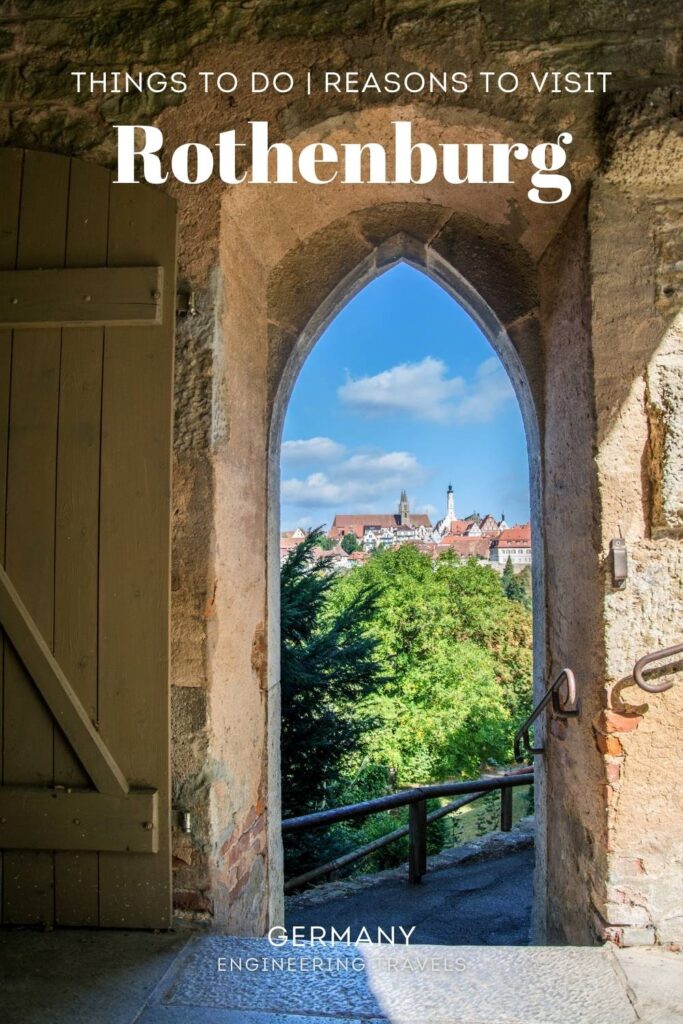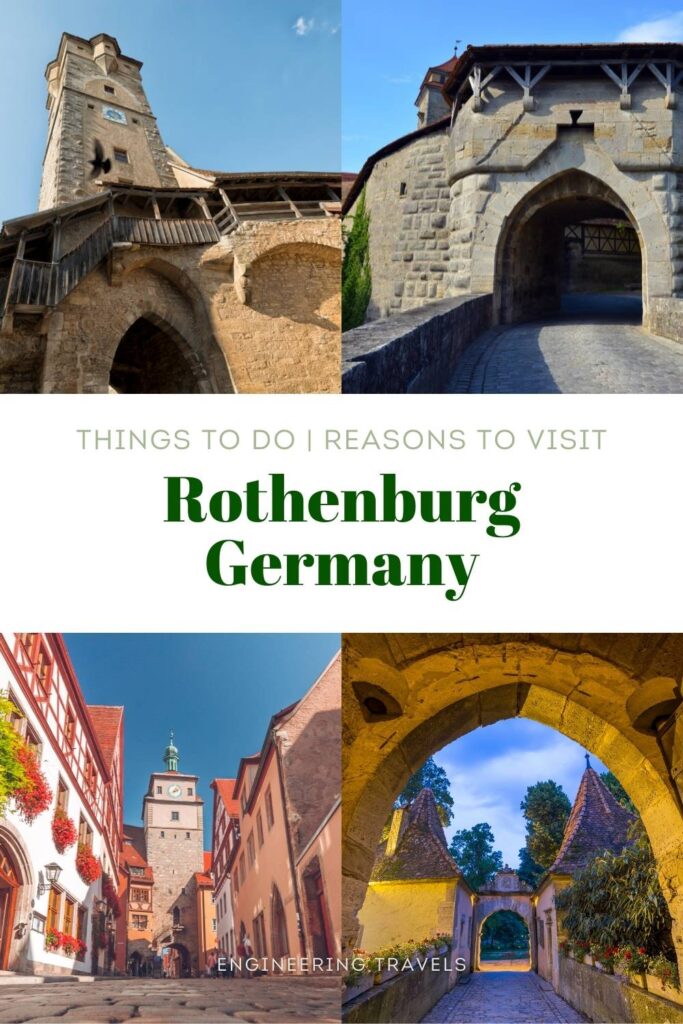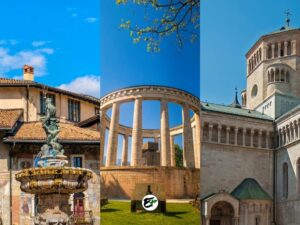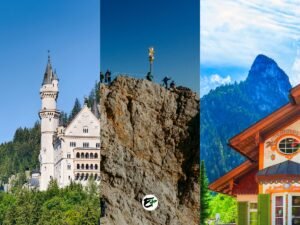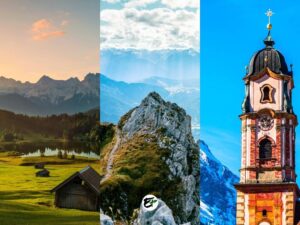Rothenburg ob der Tauber: 27 Things to Do, 7 Reasons to Visit
Southern Germany offers an array of destinations that can transport travelers back in time. Among these are Nuremberg, Bamberg, Wurzburg, Lichtenstein Castle, the Black Forest with its quaint villages, the Neuschwanstein Castle nestled in the Bavarian Alps, and so many more.
However, for an authentic medieval experience, Rothenburg ob der Tauber is unmatched. The town’s landmarks, museums, and traditions offer a comprehensive look into medieval German life. To me, it’s the reason why Rothenburg ob der Tauber is absolutely worth visiting; a must-see for everyone planning to visit Franconia or Bavaria.
Let’s not forget that Rothenburg ob der Tauber is one of only three towns in Germany with fully intact medieval walls. And if you’re an explorer like me, you’ll be pleased to know that you can walk along these ramparts!
This is just the start of the thrilling experiences awaiting you in Rothenburg ob der Tauber. And talking about the activities in Rothenburg, there are literally dozens for you to explore and experience! Allow me to share my knowledge of Rothenburg and assist you in making the most of your trip to Rothenburg ob der Tauber, should you choose to visit.
This post contains affiliate links. I may receive a tiny commission at no additional cost to you.
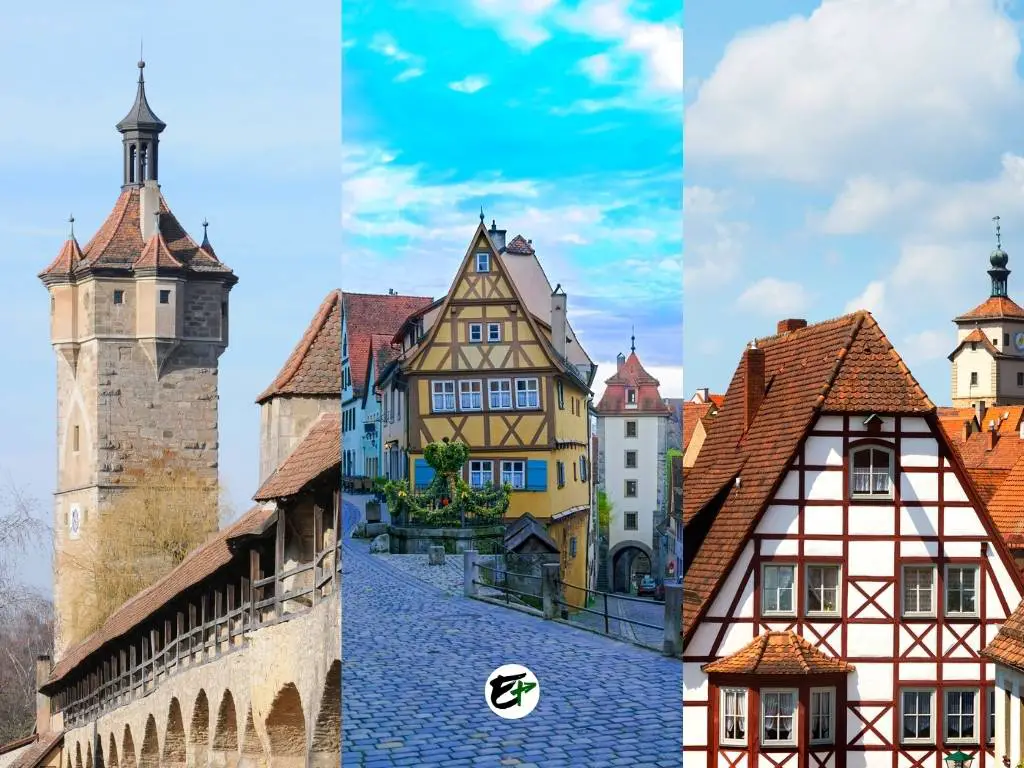
Use the table of contents to skip to topics.
To provide a summary of your experience in Rothenburg ob der Tauber and to show how quaint this place is, take a look at these inspiring photos I’ve prepared for you.



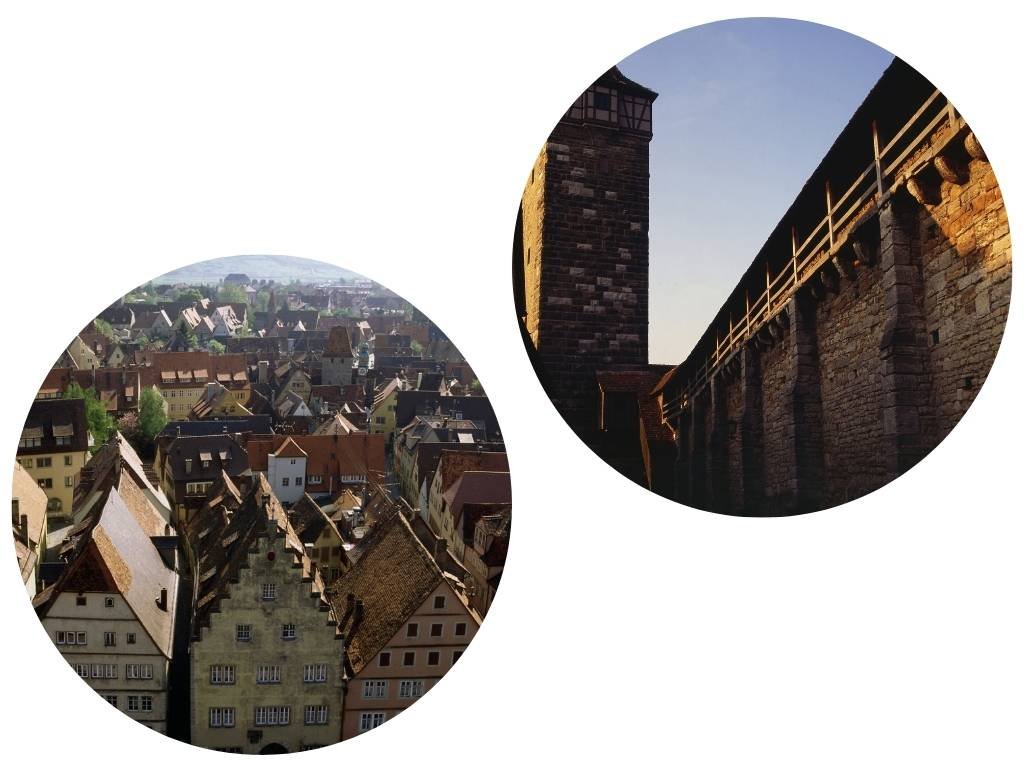
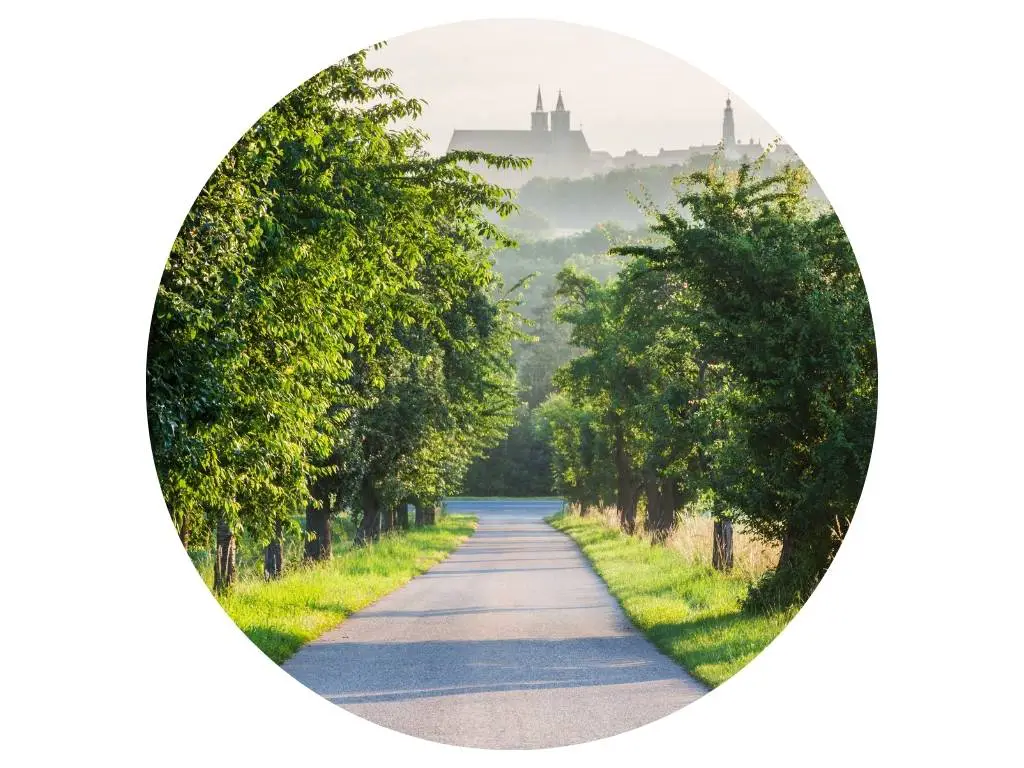

If you’re considering spending a few days in Rothenburg ob der Tauber to explore this beautiful town, you can find excellent hotel deals here. I suggest participating in at least one town tour for an insightful visit to one of Germany’s most fascinating towns.
Now, consider me as your virtual travel guide to Rothenburg ob der Tauber.
I. The Highlights of Rothenburg ob der Tauber
There’s no denying it, Rothenburg is charming, and its beauty is the primary reason to visit Rothenburg ob der Tauber. From the cobblestone streets to the timber-framed houses, the entire town feels like an open-air museum!
Did you know that Rothenburg ob der Tauber is so beautifully iconic that it has become one of the most recognized faces of Germany on the internet? Later, you can try searching for “Germany” on your preferred image search engine. I’m confident that the results will frequently display Plönlein, a key landmark of Rothenburg ob der Tauber.
1. Plönlein
When you visit Rothenburg ob der Tauber, there is an ideal location for a selfie or a photo souvenir. You might wonder where this spot is within the town. Well, it’s no other than Plönlein.

The Plönlein, which translates to “Small place by the fountain”, is a charming little square in Rothenburg ob der Tauber. While many people think the term Plönlein refers to a single yellow half-timbered house, it actually encompasses an entire square filled with various buildings.
This picturesque spot includes a fountain and two towers from the old city wall – the Siebersturm on the left, leading to the Hospital district, and the tower of the Kobolzeller Tor from 1360 on the right, showing the way to the Taubertal.
The Plönlein is quite famous and has been featured in various forms of media. For instance, its architecture was used as a backdrop in the Walt Disney classic “Pinocchio” (1940). Since then, it has been repeatedly used by artists, architects, and designers to depict a typical medieval European setting.
So, you’re wondering where Plönlein is and how you can get there? It’s quite simple to locate. Begin at the Marktplatz in Rothenburg ob der Tauber. From the southeast corner of the market square, head south via Schmiedgasse.
In just about 5 minutes, you’ll find yourself in Plönlein. For the precise route, please refer to the maps provided below.
Please remember that Plönlein is a popular spot in Rothenburg ob der Tauber. It’s common to see crowds and cars, particularly during the busy season and hours. Don’t let your expectations get too high.
You might be thinking, “I want a picture of Plönlein with just me in it!” So, when is the ideal time to visit Plönlein? Consider going after 6 in the evening or early in the morning.
Day-trippers often crowd Rothenburg ob der Tauber from around 9 a.m. to 5 p.m. Once they leave, the streets are almost empty. This gives you plenty of opportunities to take photos without any photo bombers, including at Plönlein.
2. Marktplatz
In contrast to Plönlein, when it comes to Rothenburg’s Market Square, I have a different preference. I enjoy seeing it bustling with activity, crowded, and full of life — just as any town center should be. The sight of such a place teeming with people brings me joy and excitement.
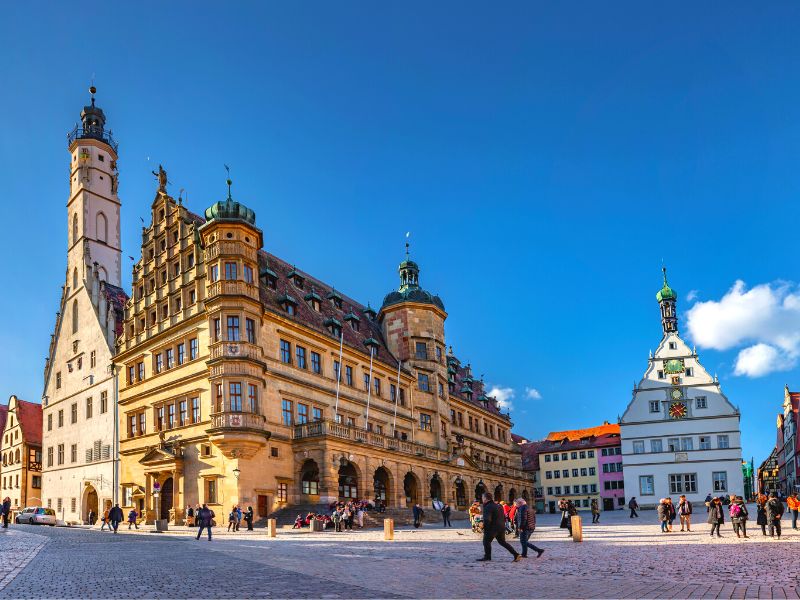
And indeed, in addition to Plönlein, another notable place to visit in Rothenburg ob der Tauber is the Market Square, also known as Marktplatz. This area represents the pinnacle of Rothenburg ob der Tauber’s culture and architecture.
At Marktplatz, you’ll find yourself surrounded by a variety of impressive structures. This is also where you can experience various events that showcase the traditions of Rothenburg ob der Tauber. In the sections that follow, you’ll discover the traditions of Rothenburg that I find particularly captivating.
a. Tourist Information Center
Standing in the middle of Rothenburg’s Market Square and facing north, you will see the former council drinking room of the town, which now serves as Rothenburg’s Tourism Office.
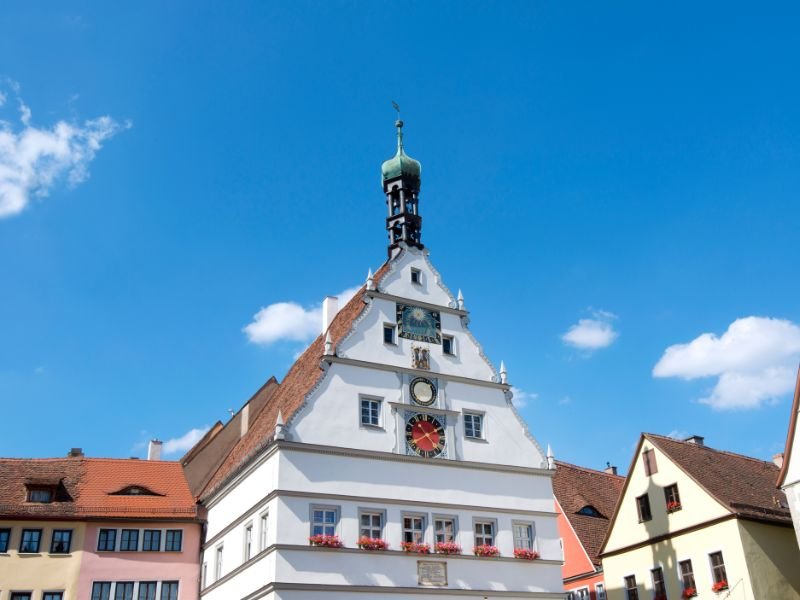
This is where you can obtain guides and gather a wealth of information about the town. You can also find pamphlets in various languages about Rothenburg ob der Tauber, as well as posters of upcoming events.
On the facade of the Tourist Information Center, there is a clock and a sundial dating back to 1683 and 1768 respectively. Every hour on the hour, from 10 a.m. to 10 p.m., a show about the history of Rothenburg takes place on the facade of the Tourist Information Center. Be sure to make time to watch it!
b. Town Hall
Still in Marktplatz, when you look to the east, you will see various gift shops, souvenir stores, and cafes. You can also see alfresco seats where you can take a break and admire the building across the way: Rothenburg’s town hall.
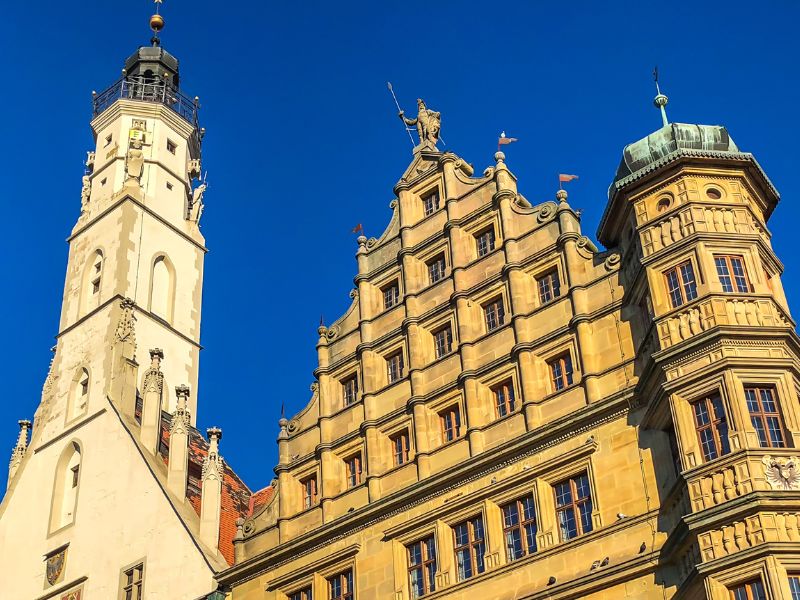
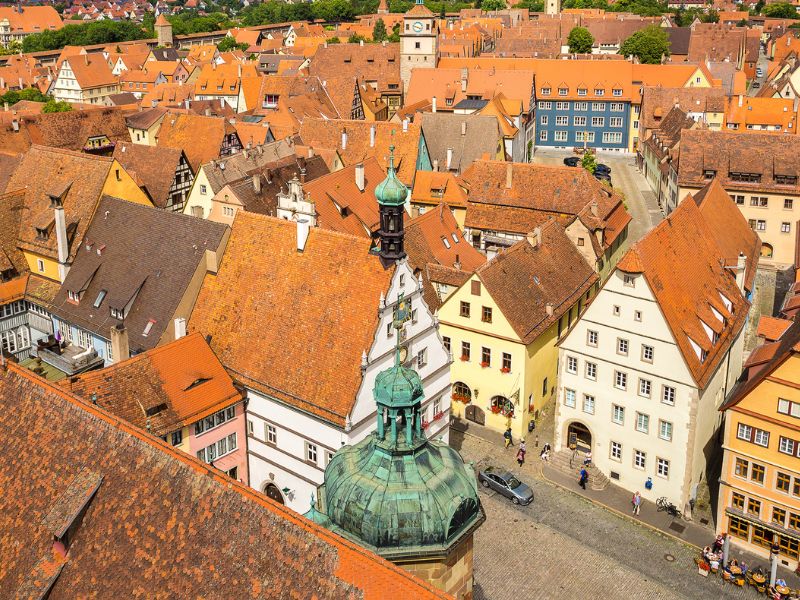
The Town Hall of Rothenburg ob der Tauber is a standout building in the town. This 13th-century structure blends Gothic and Renaissance architecture, featuring an array of skylight windows and a large stone portico that opens onto the main square. In the medieval ages, the Town Hall served as the power center of the city-state of Rothenburg. It was a symbol of pride for the city’s past residents.
Aside from appreciating the Town Hall from the Market Square grounds, know that you can also ascend its 220-step tower for a unique view of the city. From the top, you can see the centuries-old town quarter and the nearby Tauber valley, much like a medieval sentry.
Please note that the Town Hall’s opening hours may vary. It is recommended to check the official website of Rothenburg’s tourism office before your visit. The admission fee is also listed on this website.
c. Marktplatz Impressive Landmarks
In the southern part of Marktplatz, you’ll find the rest of the square’s most impressive landmarks. Georgsbrunnen is one of them. Nearby, there are some of the town’s most notable timber-framed houses. These include the Butcher’s & Dance Hall and Mayor Jagstheimer’s House.


Did you know that the Georgsbrunnen, or St. George’s Fountain, is not just any ordinary fountain? It’s actually the largest well in Rothenburg ob der Tauber, with a depth of 8 meters and a capacity of a whopping 100,000 liters. Built way back in 1446, it features a fascinating sculpture of a cavalier conquering a devilish creature.
Now, let’s talk about the Butcher’s & Dance Hall. It’s a place of contrasts. Imagine this – upstairs, people are celebrating festivals, while downstairs, the butcher is selling his wares. The architecture is quite unique too, with a slim patrician house and a half-timbered gable that reaches for the sky. Today, it’s a hub for contemporary art.
Last but not least, the Mayor Jagstheimer’s House is a sight to behold. Built in 1488 for a Lord Mayor, it has a beautiful courtyard and a magnificent half-timbered gable with an oriel window. And guess what? In 1513, Emperor Maximilian I was a guest here. It’s a colorful timber-frame house located near the main square.
It’s in this area that we can find some of the most fascinating museums in Rothenburg, such as the ‘Historical Vault’. We will discuss this further later.
3. Markusturm and Röderbrunnen
From Rothenburg’s Market Square Saint George’s Fountain, head straight east. In just a few minutes, you’ll pass by Markusturm or Marcus Tower and reach another highly photographed location in Rothenburg.
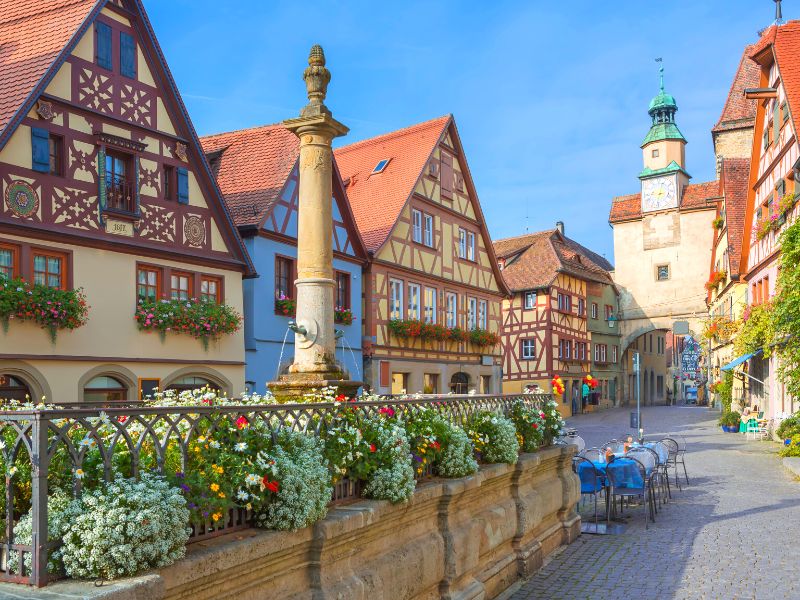
In this area, you’ll find Röderbrunnen, a fantastic viewpoint to appreciate the city’s architecture. I suggest getting closer to Röderbrunnen. Position yourself behind the well and face the tower. From this spot, you’ll enjoy a picturesque view of pastel-colored timber-framed houses lining the road, leading to the arch opening below Marcus Tower.
Wondering when to photograph Marcus Tower and Röderbrunnen? Don’t miss the chance to visit during Easter. At this time, most fountains, including Röderbrunnen, are decorated with flowers and colorful Easter eggs to bless the water. The vibrant decorations will complement the surrounding timber-framed houses in your photo.
In addition to their picturesque features, Markusturm actually also have interesting significant historical value.
Did you know that the Markusturm is a tower from the 13th century that was part of the inner wall of Rothenburg ob der Tauber? It functioned as a watchtower and lookout point, enabling guards to monitor for any potential threats coming from afar.
Today, it has a new role. It’s part of a hotel that was constructed in 1264 and is situated at the location of the Markusturm tower in medieval Rothenburg.
II. Rothenburg ob der Tauber’s Beautiful Churches
Rothenburg ob der Tauber is an architectural wonder, housing numerous marvels within its walls. Aside from the half-timbered houses, the town also has impressive churches! This makes it a delightful place to explore, particularly for those who enjoy wandering, like myself!
Most importantly, the churches in Rothenburg ob der Tauber, similar to other European churches, are home to remarkable artistic religious artworks. If you appreciate such discoveries, I’m confident you’ll find Rothenburg ob der Tauber enjoyable.
A particularly notable church in Rothenburg ob der Tauber is Saint James Church.
4. Saint James Church
St. James Church, also known as St. Jakob, is a beautiful Lutheran church nestled in the heart of Rothenburg ob der Tauber. It’s a historic gem, with construction spanning from 1311 to 1484. Today, it serves as a significant stop for pilgrims on their journey to the St. James Church in Santiago de Compostela, Spain.
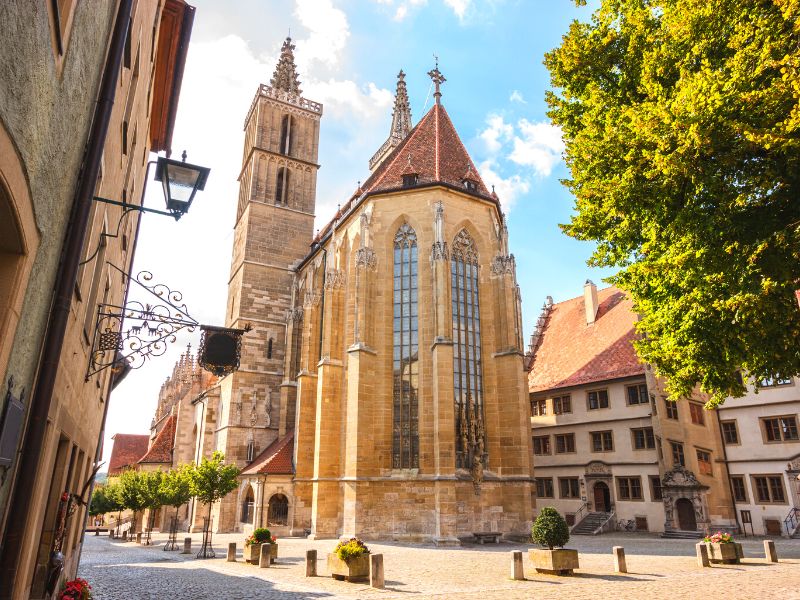
When you visit Saint James Church, three things are likely to impress you:
The first is the church’s choir, surrounded by towering, vibrant stained glass. These windows depict various saints and illustrate Christian beliefs. If you visit in the early morning, you’ll witness the sunlight striking the stained glass from outside, causing the windows to explode with color.
The second is the church’s Great Organ. Constructed by Rieger Orgelbau, this organ boasts 69 stops, 108 ranks, and 5,500 pipes. Beyond these impressive numbers, the organ is visually striking and is among the largest in Bavaria.
Finally, take note of the altars at both ends of Saint James Church: the Holy Blood Altarpiece and the Twelve Apostles Altar. The Holy Blood Altarpiece, crafted by Tilman Riemenschneider, is particularly exquisite. The skill with which it was carved from wood is truly remarkable.
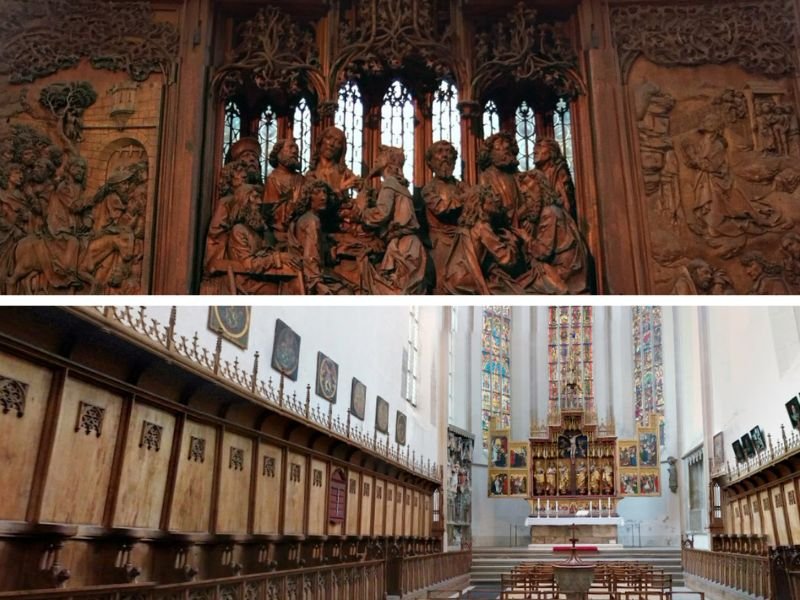
In addition to the Holy Blood Altarpiece and Twelve Apostles Altar, the Church of Saint James houses other artworks. These include portraits of Elisabeth of Thuringia, Saint Peter, and Saint Paul.
If you are visiting Rothenburg ob der Tauber for Saint James Church, it’s highly recommended to visit during the advent season, just before Christmas. At this time, you can enjoy a free organ concert that lasts for 30 minutes. This can provide a welcome break after exploring Rothenburg’s Market Square.
How do you get to Saint James Church in Rothenburg? After exploring Rothenburg’s Market Square, another tourist attraction is just a short distance away.
Head to the northwestern part of Market Square and follow the road known as Grüner Markt, or Green Market. After a brief stroll, you’ll come across Saint James Church, a gothic structure from the late 15th century, distinguished by its towering spires.
For more information that can help you with your visit to Saint James Church, please check out the official website of Rothenburg ob der Tauber.
5. Saint Peter and Paul Church
The Church of Saint Peter and Paul is another point of interest in Rothenburg ob der Tauber. Unlike Saint James Church, the Church of Saint Peter and Paul is smaller and located on the outskirts of the town. You can find it in a village called Detwang, which is situated beside the river Tauber.

Unless you have a car, expect a 20-minute hike to the village from Rothenburg ob der Tauber’s Market Square. Detwang is a small village with a countryside ambiance, established in the 10th century. Here, you’ll see farms, meadows, and houses similar to those in Rothenburg.
Inside the Church of Saint Peter and Paul, you’ll find another work by the famous Tilman Riemenschneider at the altar. However, there is a small entry fee.

Since you’ll be hiking to visit the Church of Saint Peter and Paul, it’s crucial to check its opening hours from Rothenburg’s Evangelical Church website beforehand.
6. Saint Wolfgang Church
On your journey from Rothenburg town center to Detwang, you’ll come across Saint Wolfgang Church. This unique church is attached to Rothenburg’s walls and features artistic late-Gothic tracery and three altars from the 1500s, during the Riemann Schneider Period.
You know, it’s fascinating to think that the early inhabitants of Rothenburg used a church for military defense. Inside the church, narrow passages with steep steps lead to impressive underground defense chambers. The thick walls and arrow slits provide a glimpse into the soldierly life during medieval times in Rothenburg.
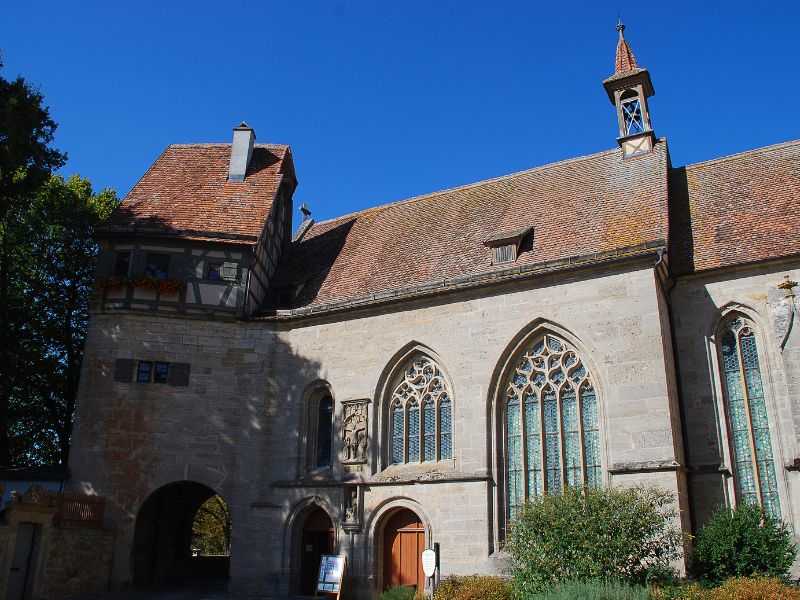
Saint Wolfgang Church, also known as the “Shepherd’s Church,” is dedicated to Saint Wolfgang, the patron saint of shepherds. In the past, sheep farming was a significant part of Rothenburg’s medieval economy. The shepherds would come to this church to pray to Saint Wolfgang in this church for blessings on them and their livelihood.
To find Saint Wolfgang Church, start at Rothenburg’s Market Square and head towards Saint James Church. Look for the tunnel under the western section of the church and continue walking northwards on Klingengasse street. After a few blocks, you should see the Klingentor tower in the distance. Pass under the Klingentor Tower, and you’ll arrive at Saint Wolfgang Church.
III. Rothenburg ob der Tauber’s Medieval Wall
What I love about exploring old cities and towns is the opportunity to discover fascinating places and things simply by strolling around and following my instincts. This is particularly true for Rothenburg ob der Tauber. Like, the preserved medieval center of Rothenburg is merely the starting point for the many discoveries awaiting you in this town!
Venture a bit beyond the medieval center, and you’ll encounter Rothenburg’s well-preserved medieval walls, a must-see attraction in the town.
When visiting the medieval walls of Rothenburg, it’s not hard to marvel at the fact that these walls have stood intact for hundreds of years, surviving several battles and wars. Even World War II, which ravaged the city with bombs, couldn’t bring these walls down.
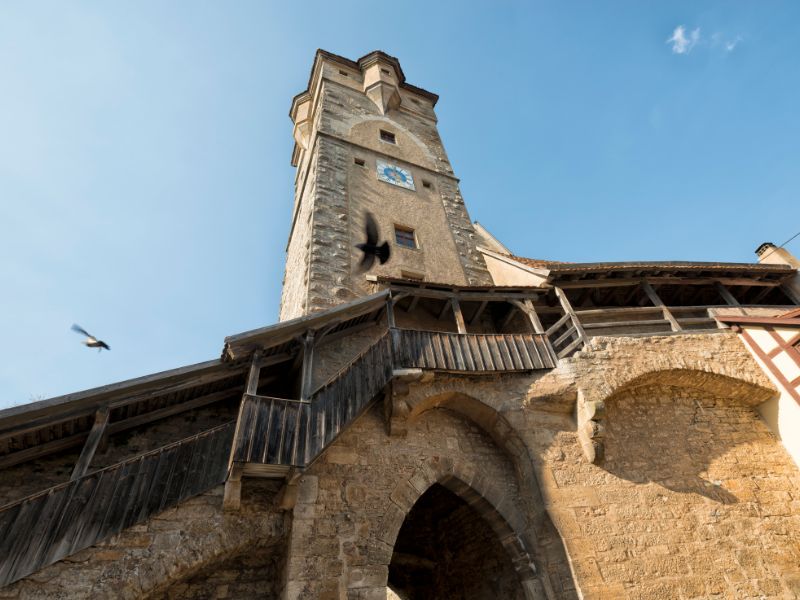
However, it’s important to note that the walls were not completely spared from the bombings. The reconstruction and preservation of the walls are a testament to the proud residents of the town, to whom we owe a debt of gratitude. Without their efforts, we wouldn’t be able to experience the fantastic medieval ambiance of Rothenburg as we do today.
Today, these walls stand as one of the main reasons to visit Rothenburg ob der Tauber. You know, while cobblestone lanes and quaint timber-framed houses can be found elsewhere in Germany, these walls are unique – only three such structures remain in the country!
Like it was stated in the beginning of this article, one of the best things you can do in Rothenburg ob der Tauber is to walk along the ramparts of the medieval wall of the town. It’s an unmissable experience, particularly for people who are from younger countries where these structures simply do not exist.
So… If you’re planning to visit and explore the walls of Rothenburg ob der Tauber, be aware that the walls extend for approximately 4 kilometers, connecting several towers. To fully appreciate Rothenburg’s medieval wall, you’ll need around 2 to 2.5 hours.
There are various ways to explore each tower and section of the wall, but I recommend following Rothenburg’s Tower Trail. This trail traces the perimeter of Rothenburg’s city wall and offers numerous photographic opportunities, as well as scenic views from atop the wall and its surroundings.
As you journey along Rothenburg’s Tower Trail, you’ll encounter information boards that provide historical context, significance, and features of different sections of the wall. To enhance your experience, consider picking up a brochure from the Tourist Information Center. This way, you can absorb the facts at your own pace while strolling, without needing to stop at every information board.
And where should you start and end the Tower Trail? The Tower Trail in Rothenburg has multiple entry and exit points along different sections of the wall. There are stairs and passages interspersed between various stages of the trail, such as the wall towers.
If you’ve visited Saint Wolfgang Church, which we discussed earlier, you may have noticed the stairs built at the side of the Klingentor tower. This is just one of the points where you can begin or conclude your hike on the Tower Trail.
During your hike on the Tower Trail, you’ll encounter towers and structures with fascinating architecture. Here are some of the most interesting buildings to look out for, arranged clockwise starting from the north:
- Klingentor (Klingen Gate)
- Galgentor (Gallows Gate)
- Rödertor (Röder Gate)
- Gerlachschmiede (Blacksmith’s Shop)
- Spital Gate (Hospital Tower and Gate Bastion)
- Rossmühle (Old Horse Mill)
- Burgtor (Castle Gate)
Let me quickly introduce to you each feature of the medieval wall of Rothenburg ob der Tauber.
7. Klingentor
Let’s begin with the northern entrance to the town, the Klingen Gate. In this section of the wall, you’ll find the fortification of the Klingen Gate Bastion. This includes the fortified church of Saint Wolfgang and the 37-meter high Klingen Tower, considered the most beautiful tower in Rothenburg ob der Tauber.
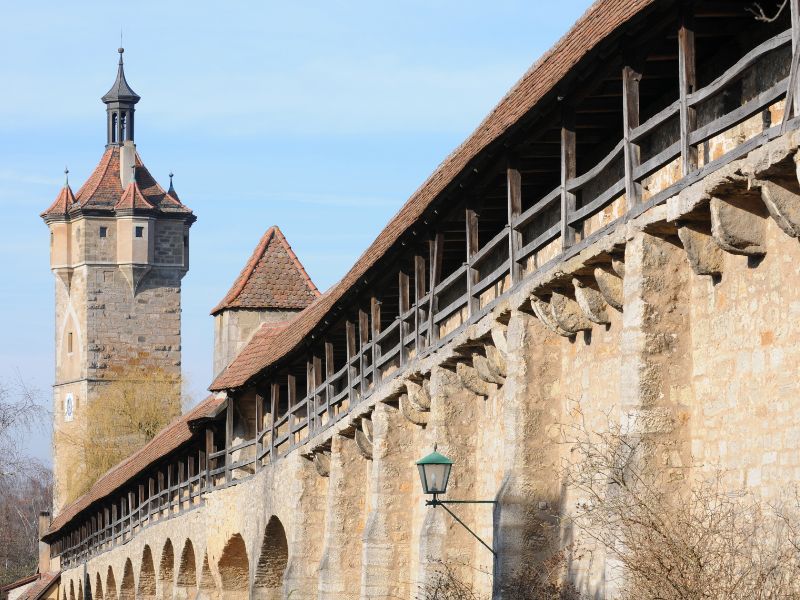
Here’s a fun fact: The name of the Klingentor Tower originates from the gorge that drops steeply down to the Tauber valley. Since the 16th century, the tower has served the town in a unique way. It was converted into a water tower after the installation of a copper vessel. Ever since, it’s been supplying water to the town’s drinking fountains!
By the stairs of the Klingentor tower at the inner face of the wall, you can access a roofed walkway. This walkway leads you to other parts of the Tower Trail.
8. Gelgentor
Moving eastward from the Klingentor, you’ll encounter the Galgentor as part of the wall. The Galgentor, or Gallows Gate, derived its name from the gallows that once stood in the Little Head Meadow just outside the gate.

Beyond the Galgentor, you’ll find a moat system, an intriguing defensive feature of the wall that seems straight out of a medieval fantasy movie. In Rothenburg ob der Tauber, these features are very real.
The Galgentor gate dates back to 1388, following the first expansion of the town. Nearby, you’ll find two-story artillery posts where crossbowmen and musketeers once defended the town from arrow slits. A visit to the Galgentor offers a deeper understanding of the battles that took place in Rothenburg, particularly in this vulnerable part of the city.
9. Rödertor
In Rothenburg, there are only two towers that you can ascend: The Town Hall tower and Rödertor.
The Röder Tower, standing tall and proud, is the only true observation tower along Rothenburg’s town wall. It served as the city’s eyes, with watchmen signaling from its top to the city center, informing whether all was well or danger was looming. What’s more, it’s the only tower you can climb, all 103 steps of it, to enjoy a special exhibit about the tower and the breathtaking views it offers.

Just in front of the watchtower, you’ll find the Röder Gate. This multi-stage gate, complete with two stone bridges (which were once drawbridges), leads over the town’s dry moat. As you pass through, you’ll notice armed curtain walls, guardhouses, an elevated gatekeepers cottage, and three archways.
At the end of the gate system, you’ll see beautiful twin huts with pointed roofs. These were used as a toll booth and customs house starting in the 1300s, controlling the flow of goods and people into the city.
The name “Röder” has an interesting origin. It roughly translates to “Woodsman” in German and comes from a small hamlet called Röder that once sat just outside Rothenburg in this direction. Although the hamlet no longer exists, its memory lives on in the name of the tower and gate.
10. Gerlachschmiede
As you wander through the covered walkway of Tower Trail from Rödertor, one of the intriguing buildings you’ll encounter is the Gerlachschmiede, or Blacksmith House. This unique house, which dates back to 1469, is visible from the Tower Trail’s covered walkway and is just a minute’s walk away from Rödertor.
Once you spot it from the walkway, I’m certain you’ll feel compelled to take a brief detour from your Tower Trail journey to visit the Blacksmith House. This uniquely shaped building in Rothenburg is one of the town’s most playful structures.
While you can already see it from the trail, I suggest appreciating its appearance from the streets for a closer look.

From the streets, try to see both the southern and northern facades of the Blacksmith House.
The southern front of the house is well-known for its unique shape and intricate details, including a roofline hoist and a coat of arms featuring a crowned green snake holding blacksmith tools. The northern side of the house is equally captivating with a horse-shoed carriage door used for unloading goods and a medieval-style iron business sign indicating the year of construction, 1469.
As you admire the house, you’ll likely be intrigued by the coat of arms displayed on the front facade. The emblem, depicting a green snake entwined with blacksmith tools, may leave you wondering about its significance. Why a snake, and not a man? It’s a question that might pique your curiosity.
If you’re visiting during the Summer or Fall festivals, you might get a chance to see blacksmiths working their irons in Green Square (Grüner Markt).
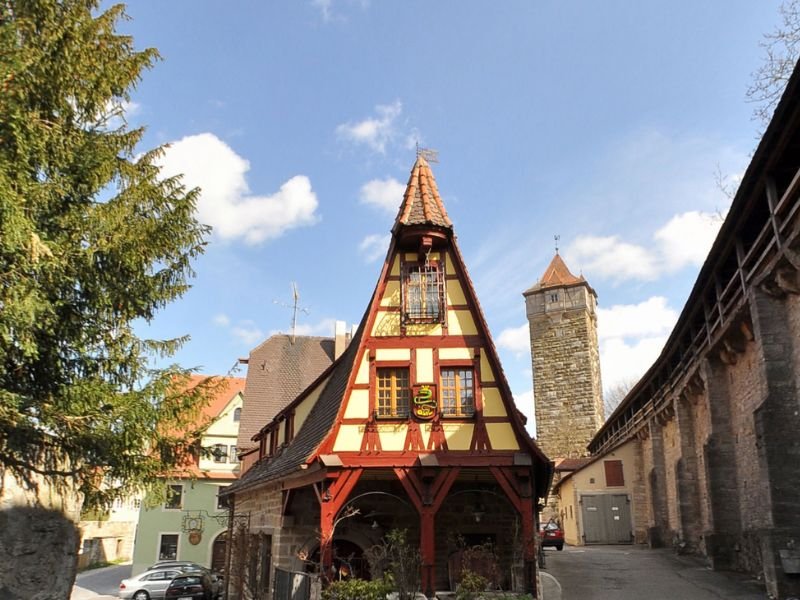
There are two excellent spots for photographing Gerlachschmiede. The first is located directly in front of the house, slightly to the west. From here, you can capture the house with Röder Tower looming in the background. The second spot is on the covered walkway, offering a view of the house’s roof and windows in perfect symmetry.
11. Spital Gate
Among the gates of Rothenburg, the Spital Gate (or Spitalbastei) is considered unique due to its figure-eight or infinity shape. As you enter the gate, you’ll be greeted by an inscription “Pax intrantibus, salus exeuntibus,” which translates to “Peace to those who enter and salvation to those who leave.” This makes the Spitalbastei arguably the “friendliest” gate in Rothenburg ob der Tauber.

Actually, Spitalbastei is only friendly to visitors — not to enemies!
The Spitalbastei is the city’s most formidable bulwark. It was constructed in the 16th century by Leonhard Weidmann specifically for the Spital Quarter.
Actually, it was designed to serve as a deterrent. This was achieved through its exaggeratedly bulky construction and a multi-door system, making it a fascinating piece of architecture.
When you visit Spitalbastei, check out its cannon gallery that would have decimated any enemies attacking Rothenburg from the south. Exploring the bastion allows you to appreciate medieval warfare, something typically only seen in movies.
The Spital Gate marks the southernmost tip of Rothenburg’s fortifications. Once you reach it, you’ve completed half of the Tower Trail and seen everything on the eastern city wall.
From the Spital Gate, the Infirmary Hospital and Spital Quarters will be the first section of town you encounter as you continue your stroll northwards through the western section of the Tower Trail.
The Infirmary Hospital and the Spital Quarter were established in the late 13th century by a foundation, the Knights of the Hinterland, to aid the sick and poor. These parts of Rothenburg were the last to be integrated into the city at the start of the 15th century.
In the vicinity of the Spital Quarters, there are three remarkable buildings and areas that are worth a visit:
- The Hegereiter House is the kitchen of the Infirmary hospital, notable for its intriguing witch-hat shaped roof. This structure was the handiwork of the renowned stonemason Leonard Weidmann, who is also credited with the creation of the Spital Gate.
- Next is the Stöberleinsturm, also known as the Little Flushing Tower. This beautiful tower is characterized by its symmetrical corner turrets.
- Lastly, Stöberlein’s Stage is an open-air mini-amphitheater that faces a covered stair walkway. This spot is a must-visit during a Rothenburg festival, where you have the opportunity to experience a traditional medieval play.

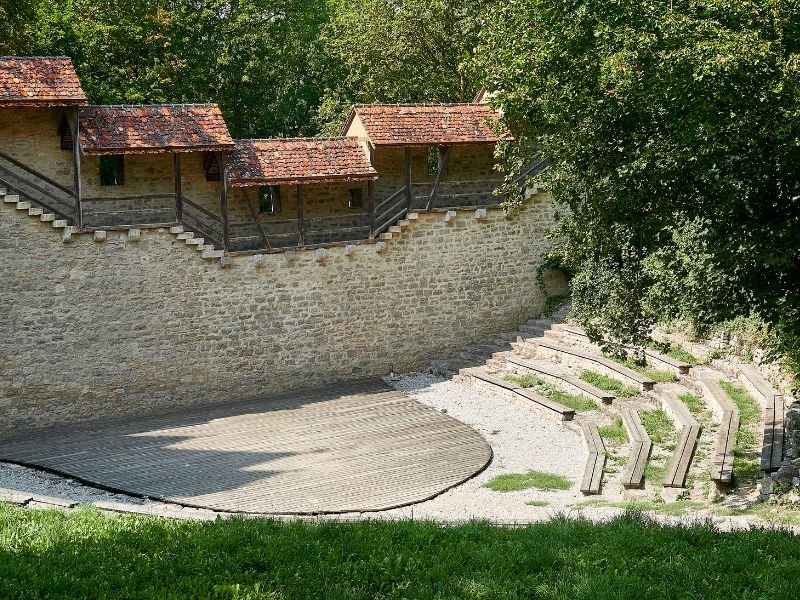
12. Rossmühle
If the eastern wall of Rothenburg has the Blacksmith’s house, here in the west, you’ll find Rossmühle.
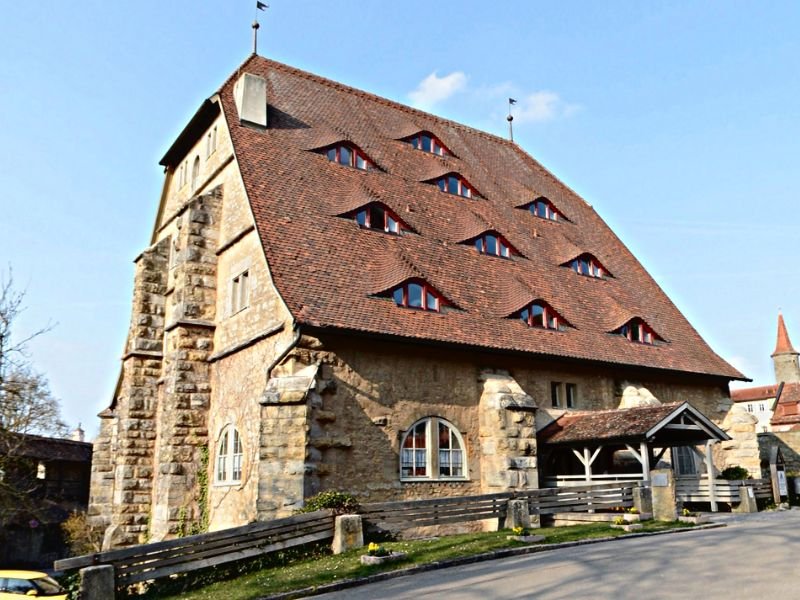
The Rossmühle, located on the western wall of Rothenburg, is a site of historical significance and functionality. Constructed in 1516, it served as a corn mill, providing Rothenburg with a reliable source of ground grain during times of war or low water levels when the grain mills in the Tauber Valley could not meet the city’s needs.
Interestingly, it was reportedly the largest mill in Southern Germany, with its mill wheels powered by 16 horses, indicating the scale of its operations.
Since 1957, the Rossmühle has been repurposed as a modern youth hostel and an international meeting place, all within the historic ambiance of the hospital district.
Today, it is recognized for its architectural beauty and is considered a must-see for anyone exploring Rothenburg ob der Tauber.
To me, the Rossmühle is arguably the most beautiful house outside the once-standing inner wall of Rothenburg. Its roof is architecturally captivating, and the windows appear as if a giant pinched the roof, pulling it slightly upwards. Its captivating architecture will undoubtedly draw your camera lens and compel you to capture its image.
After visiting Rossmühle and moving northwards, a quick stop at Plönlein before returning to the Tower Trail is possible. This is particularly true when heading north from Spital Gate towards Plönlein or Kobolzeller Tower.
At this juncture, there are two options: continue the Tower Trail within the town or take a hike outside the city walls for views of the Tauber Valley. Regardless of the chosen path, one destination remains constant: Burgtor.
13. Burgtor
Rothenburg ob der Tauber’s westernmost gate, known as Burgtor or Castle Gate, was constructed around 1460. This gate is notable for having the highest gate tower among the city’s fortification system, as well as a semicircular customs and guardhouse.

The top of the gate proudly displays the coat of arms, which, along with the old stone roof fashioned in a witch-hat style, provides an imposing entrance to the town. The high tower in the middle adds to its impressive appearance.
Intriguingly, during medieval times, early residents of Rothenburg did not always enter the castle gate the way we do today. The residents of Rothenburg had a different experience with the Castle Gate.
At night, entry through Burgtor was quite limited. Instead of opening the entire gate, which was deemed too dangerous, residents would pass through a small door inset into the gate, known as the ‘narrow eye of the needle’. It is manhole door that dates back to 1555.
IV. Scenic Views from Rothenburg ob der Tauber
Situated at a height of 430 meters, the town overlooks the Tauber valley, offering visitors a pleasant view of the surrounding landscapes. This is particularly true on the town’s western edge, where the scenery harmonizes with the medieval ambiance of Rothenburg.
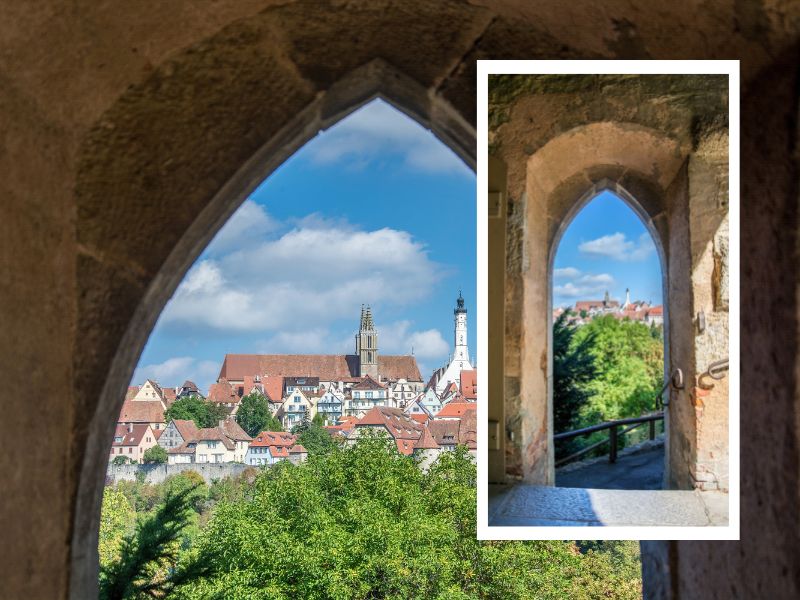
Observing the area, you’ll find minimal signs of modern life. There are no skyscrapers or wind turbines, just nature and a few old looking houses below.
I believe it’s a compelling reason to visit Rothenburg. Because, with that view, I bet you’ll find it easier to make your fantasies a reality. It might sound silly, but I’m sure you’ve imagined yourself in a medieval movie before, right? Perhaps, you are a prince or princess, a wanderer, or a missionary sent by a king.
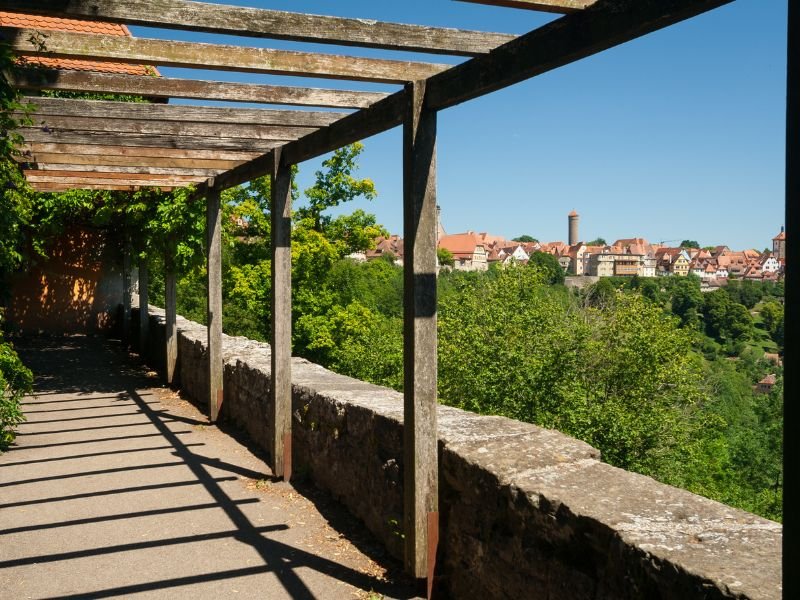
What could be more exciting? You can also take in the skyline view of Rothenburg from various viewpoints around the town. There are two spots on the western side of Rothenburg that offer a view of the city skyline:
- Kalkturm (LimeTower) – This is the westernmost tower near the Spital Quarter, situated southwest of Rossmuhle. It offers a direct view of the skyline of Rothenburg’s town center (looking north). To see the best views, you need to go through the passageway in the tower down to the hiking trails.
- Castle Gardens – This is a well-known viewpoint of the Tauber Valley. From here, you can see the skyline of the southern part of Rothenburg, the Spital Quarter, Rossmuhle, and more.
14. Castle Garden
The Castle Garden is undoubtedly the ideal location for observing the Tauber Valley.
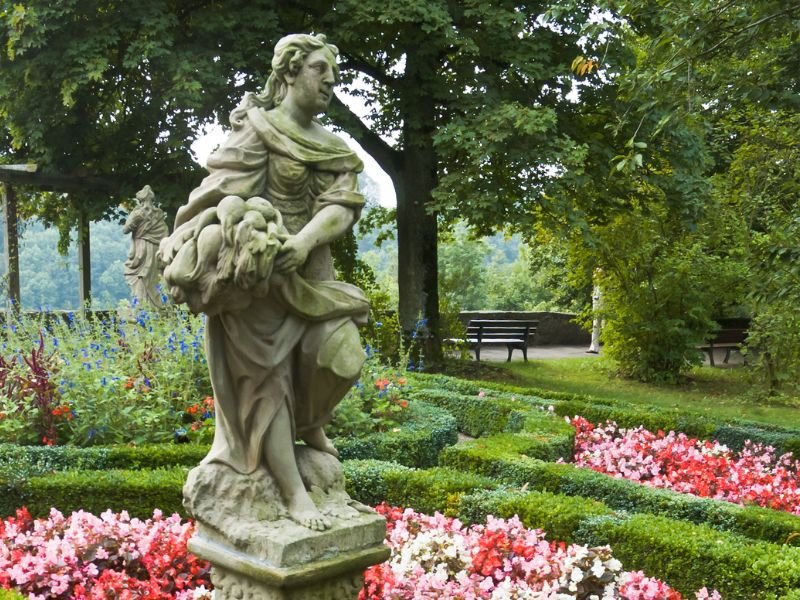
From its westernmost point, a stunning near-360-degree view of the valley and the town will fill your eyes with scenes of a genuine fairytale fantasy. The dramatic spectacle of the entire place during the golden hour is must-see. From the top, you can see the Detwang village, beer gardens, vineyards, and lush meadows!
When you visit during autumn, the scenery becomes even more enchanting. Apart from the views, the Castle Garden is known for its beautiful geometric flower beds that bloom in different seasons. It’s also a baroque garden with eight statues representing nature: the four seasons and the four elements. After a 2-3 kilometer-long stroll along the Tower Trail, it’s an excellent place to unwind.
You might be wondering, if there’s a Castle Garden, where is the castle?
In the past, a fortress called Stauferburg once stood on a portion of the current Castle Garden. While many reports suggest it was destroyed by a powerful earthquake, this has never been confirmed.
However, remnants of Stauferburg can still be found in the Castle Garden. You can check out the Staufer column on the north side of the garden or see the information panels in front of the Blasius Chapel in the Castle Garden to learn more about its history.
15. Vineyard An Der Eich
As you approach Castle Garden from Spital Quarter, the Tauber Valley’s scenic views will already enchant your nature-loving spirit along the Tower Trail. However, if you choose the Panorama Trail, which begins at Kohlturm (Cabbage Tower) and concludes at Castle Gardens, the picturesque views will touch your nature-loving soul even more profoundly.
The trail not only offers tranquil meadows and rejuvenating trees but also leads you to the photogenic vineyards owned by the Thürauf family. These vineyards are known for cultivating a variety of 160 historical grapes. A visit or a guided tour of the vineyards provides a quick glimpse into what makes the Franconian Region renowned.
16. Doppelbrücke
A short distance from the vineyards, you’ll find the Double Bridge which served as a crucial component of a significant trade route connecting Augsburg and Würzburg. This 14th-century structure bears a striking resemblance to a Roman viaduct and is made entirely of stone. From here, you can enjoy a lovely view of Rothenburg perched above the valley.
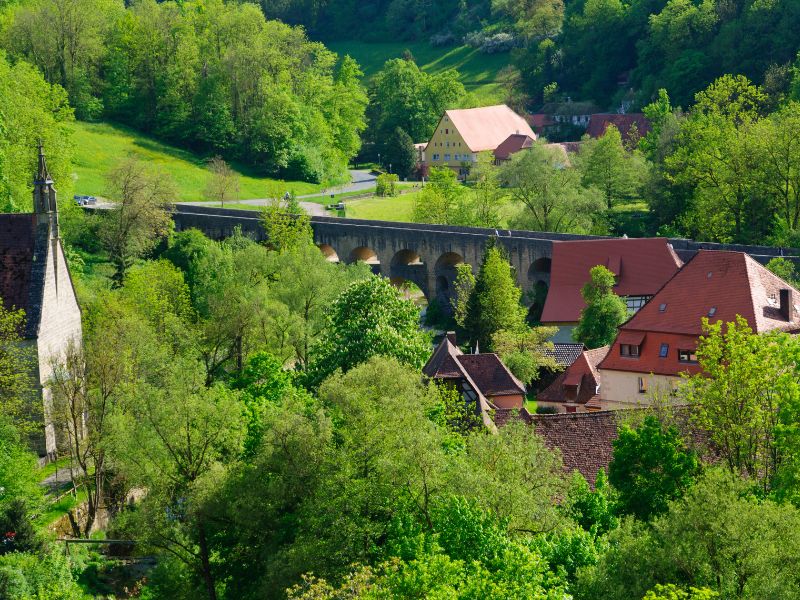
If you’re up for a bit more adventure, consider extending your journey with a 20-minute hike to the Kletterwald ropes course. It’s a great way to add a touch of wilderness fun to your day.
Lastly, the Double Bridge also offers a prime location for viewing the city’s fireworks. These typically occur on a Saturday, as part of Rothenburg’s Free Imperial City Festival celebrations.
V. The Traditions of Rothenburg ob der Tauber
Culture and tradition consistently serve as significant differentiating factors between the cities and places we visit. If you’re curious about whether Rothenburg ob der Tauber boasts an impressive culture and tradition that can still be witnessed today, the answer is a resounding yes. The city’s cultural heritage is rich and fascinating, offering an experience akin to time travel.
The city’s festivals, themed around the medieval period, feel like an authentic version of Disney, complete with fireworks. These festivals are certainly a compelling reason to visit Rothenburg ob der Tauber.
Rothenburg ob der Tauber celebrates several festivals throughout the year. When planning a trip to Rothenburg, consider these five traditions or events: the Imperial City Festival, Rothenburg’s Wine Festival, Rothenburg’s Fairy Tale Magic, the Historical Meistertrunk Festival, and the Christmas Market in Rothenburg.
Comprehensive information about these festivals can be found in the Tourism Rothenburg ob der Tauber: event highlights. Here are the summaries:
17. Imperial City Festival
Every year, Rothenburg ob der Tauber undergoes a transformation into a medieval town. Men can be seen strolling around in tunics made of cloth or leather, and women in gowns, as if time has rewound to the Middle Ages. The town hosts 27 historical groups representing different eras, all contributing to the reenactment of Rothenburg’s history.
Visitors can witness torchlight processions, enjoy the music of medieval bands playing cheerfully on the streets, and encounter men in knight costumes. The city is illuminated by fantastic fireworks that light up the night sky. Various parts of Rothenburg are set up to depict life in the Middle Ages.
Near Rodertor, you’ll find a knight camp, and tents where blacksmiths and falconers demonstrate their crafts and skills. The streets come alive with historical and musical plays that will captivate you. The experience is truly extraordinary!
If you’re planning a trip to Germany, the Rothenburg Imperial City Days Festival is an event to consider. This festival takes place during the first weekend of September every year. The event kicks off on a Friday at the double bridge with a torchlight procession to Marktplatz.
18. Rothenburg’s Wine Festival
Rothenburg always maintains its Franconian spirit! In the Grünen Markt and Kirchplatz of Rothenburg’s old town, vineyard owners and wine vendors host a fun and relaxed event to showcase the region’s specialty: winemaking.
Attendees can sample a variety of excellent Franconian wines and non-alcoholic beverages, and even make new friends. Gourmet cuisine, worthy of a Michelin star, is also available for tasting.
19. Rothenburg’s Fairy Tale Magic
Germany is the birthplace of many fairy tales that have captivated us since childhood. During the Fairy Tale Magic event in Rothenburg, these stories, ranging from classic tales by the Brothers Grimm to more contemporary narratives, are brought to life. The city hosts plays based on these stories, which perfectly complement Rothenburg’s medieval atmosphere.
While the event may seem ideal for children and family outings, adults can also find plenty of enjoyment. Concerts, guided tours, and even a donkey walk are available for all visitors to enjoy. The dates for the Fairy Tale Magic event can be found in the city’s calendar of events.
20. Historical Meistertrunk Festival
Rothenburg ob der Tauber has experienced several conflicts throughout the centuries that have forever shaped the city. One such conflict was the Thirty Years’ War, which brought both religious reformations and a new tradition to the city, now known as the Festival of Master Draught.
The Master Draught Festival is recognized as Germany’s UNESCO Intangible Cultural Heritage. It reenacts the story of Mayor Nusch, who saved the city from destruction ordered by General Tilly.
The story doesn’t involve a typical fight or combat, but rather an intriguing heroic drinking game! Mayor Nusch managed to save the town by successfully drinking one full tankard (3.5 liters) of wine in one go, thereby winning General Tilly’s “gamble and promise” to spare the town if the tankard could be emptied in one shot.
The reenactment of Mayor Nusch’s tale during the Master Draught Festival is accompanied by various celebratory activities, similar to those of the Imperial City Days Festival. This event typically takes place during Pentecost in the summer month of June.
The exact dates and the festival’s program can be found on its official website.
21. Christmas Market Rothenburg
Finally, there’s Rothenburg’s Christmas market, a tradition that dates back 500 years, making it one of the oldest in Europe! During this time, the town is adorned with beautiful Christmas lights, and the Marktplatz is bustling with people and charming Christmas shops. Here’s a glimpse of the Christmas Market in Rothenburg:
VI. Rothenburg ob der Tauber’s Intriguing Museums
The festivals in Rothenburg ob der Tauber are both fun and fascinating, offering a complete medieval throwback. Attending these events today can feel surreal, providing a unique way to experience Rothenburg at a different level.
But what if you visit Rothenburg when the city isn’t celebrating any festivals? Rest assured, you won’t be disappointed. Rothenburg’s museums offer a taste of the experiences visitors get during the celebrations. In fact, they offer even more! You’ll see the exact details of the events that shaped the Rothenburg we see today.
Indeed, the city’s museums are a compelling reason to visit Rothenburg. Each museum in Rothenburg transports you into a realm of historically fascinating items.
The range of preserved objects spans from the cute and glamorous to the intimidating and horrifying. Regardless, these museums will be worth your time. Thousands of people have had great experiences, and you can expect the same!
Here are some activities and things to do in the museums of Rothenburg:
22. Germany Christmas Museum
We’ll begin with a museum in Rothenburg that allows visitors to experience the spirit of the holiday season all year round: Rothenburg’s German Christmas Museum. This museum houses an array of Christmas decorations you can imagine! From different Christmas trees, postcards, and nativity scenes to lights and candles, it’s all here.
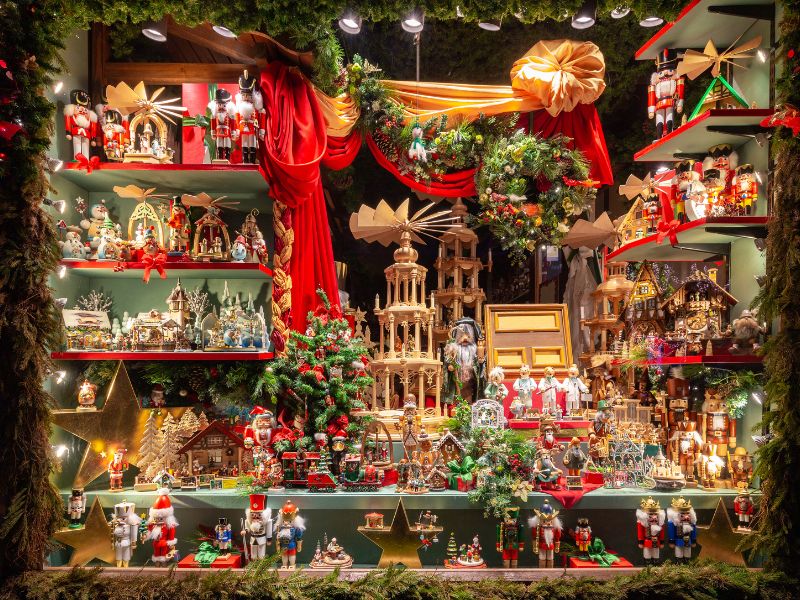
You might think, “These are just decorations. Anyone can create items like these today.” While that may be true, the Christmas decorations in the German Christmas Museum are unique and hold historical value. Some of the decorations are over a hundred years old, dating back to the early 19th century.
Even if you’re from a different religion, you can learn about the history of Christmas in this museum. You can explore the German Christmas Museum on your own and marvel at the decorations displayed throughout this 250 m2 exhibit. There’s also a guided tour available for a more insightful walkthrough.
The museum is conveniently located a few steps west of Georgsbrunnen along Herrngrasse in Rothenburg’s Market Square. Interested in visiting? Visitor information can be found on the German Christmas Museum’s official website.
23. Rothenburg’s Historical Vault
Located just in front of the German Christmas Museum, you’ll find Rothenburg’s Historical Vault.
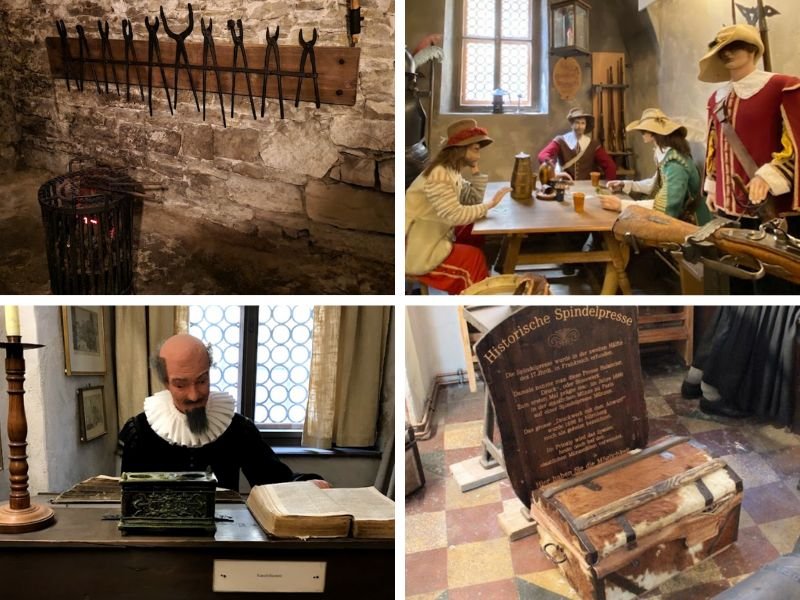
This museum further tells the story of the city, which you can learn about on the facade of Ratstrinkstube (The councilor’s drinking room) or the Tourist Information Center. The Historical Vault provides insight into Rothenburg’s history during the Thirty Years’ War, offering a glimpse into what life was like in Rothenburg during this time of religious conflict and division.
The Historical Vault, which contains 12 dungeons, is the oldest prison in Rothenburg. It houses weapons, war equipment, armor, and various tools, showcasing the military readiness of Rothenburg. You’ll also find tools used for torture, interesting articles about General Tilly, and life-size statues dressed in medieval clothes that retell the events of the Thirty Years War.
If you’re interested in visiting, you can find updated visitor information on the official website of the Historical Vault.
24. Medieval Crime Museum
For a glimpse into the unimaginable practices of the Middle Ages, a visit to the Medieval Crime Museum is a must.
This museum is conveniently located just a few minutes away from Rothenburg ob der Tauber’s Market Square. From Georgsbrunnen, simply head straight south and follow Hofbronnengasse. At the end of the lane, you’ll find the museum building, easily recognizable by the human cage inside the fence.
The Medieval Crime Museum offers a unique opportunity to explore a millennium of European and German history, specifically focusing on how authorities maintained peace and order. The museum, spread across four levels, houses a collection of both terrifying and intriguing objects.
Visitors can view the equipment and tools used for death punishments, public humiliation, and torture. The museum also features objects related to the penalization of witchcraft and sorcery. Additionally, it houses books containing medieval laws, passports, and various legal documents.
Among the most striking artifacts in the Medieval Crime Museum are the Iron Maiden, the spiky chair, and the shame masks. These items seem as if they’ve been taken straight out of a horror movie.
For those interested in visiting the Medieval Crime Museum, the latest announcements regarding opening hours and entry fees can be found on the museum’s official website.
25. Rothenburg Museum
On the northern side of the town, not far from Rothenburg’s Market Square, you’ll find the Rothenburg Museum. This museum showcases the creative character of Rothenburg through its exhibits. It houses collections of paintings, sculptures, impressive weapons, and other items that span the city’s eight-century-long history.

Art enthusiasts will particularly appreciate two beautiful paintings that depict Rothenburg frozen in time: “Stadt im Rauch” (“Town in Smoke”) by Arthur Wasse and “The Bronnen Mill in the Tauber Valley” by Theodor Alt.
Please note that the schedule and entry fee may change without prior notice. Therefore, it’s recommended to check for updates from the official website of the Rothenburg Museum before your visit.
VII. Fun Activities in Rothenburg ob der Tauber
Visiting Rothenburg ob der Tauber isn’t just about sightseeing, exploring museums, or immersing yourself in its medieval atmosphere. Another compelling reason to visit Rothenburg is the unique experiences that can only be found in this city. Here are two activities I discovered that could captivate you and fill you with wonder: Night Watchman Tour and Hot Air Balloon Ride.
26. Night Watchman Tour
Night Watchman Tour—how about joining a tour that Rick Steves describes as “flat-out the most entertaining hour of medieval wonder anywhere in Germany?” That’s a definite yes!
Night Watchmen were individuals who ensured the safety of city residents and maintained law and order. They were characterized by their black cloak, pointed weapon, and a glass box with a candle inside.
In Rothenburg today, while the attire remains the same, the role of a Night Watchman has evolved: to educate and entertain visitors during their stay.
Enjoy the humorous medieval storytelling of the Night Watchman as he answers intriguing questions such as, “Why did people once look at the window openings above you in fear?” and “Why did the Rothenburg residents once pave their streets with the rather uncomfortable cobblestones?” Listen to his humor:
27. Hot Air Balloon
In my opinion, if you have the budget and time, there’s no better way to conclude your journey in Rothenburg than with a hot air balloon ride over the city. Imagine the beauty of observing the tiny medieval buildings and towers of Rothenburg ob der Tauber from the sky. It’s an absolutely unforgettable and breathtaking experience!
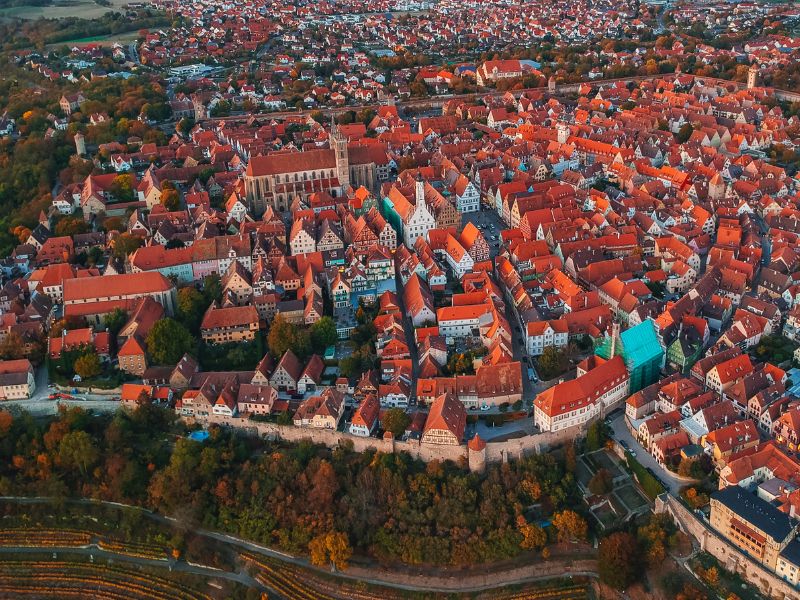
The Hot Air Balloon Ride over Rothenburg is facilitated by Happy Ballooning Ballonfahrten. They offer flights during the golden hour before sunrise and two hours before sunset in their charming hot air balloon (which isn’t always the smiling one). You and four other passengers will have the opportunity to stay airborne for 60 to 90 minutes.
When to Visit Rothenburg ob der Tauber
Rothenburg ob der Tauber is a destination that can be enjoyed all year round. However, this beautiful town truly shines during the warmer season when its half-timbered houses, town hall, and fountains are adorned with colorful flowers. Visiting Rothenburg ob der Tauber in the summer also offers the advantage of longer daylight hours, allowing you to explore more places in a single day.
The town’s streets are particularly photogenic during the summer, appearing more vibrant and colorful when the sun is shining without any cloud cover. While not every day in Rothenburg ob der Tauber is sunny during the summer, the probability of overcast weather is lower compared to winter.
On the other hand, Rothenburg ob der Tauber transforms into a winter wonderland during the colder months, complete with Christmas Markets that are among the oldest in the world!
In summary, the best time to visit Rothenburg ob der Tauber depends on the kind of experience you’re seeking.
But, if you’re planning a visit during the non-winter season, consider timing your trip to coincide with festivals like the Imperial City Festival or the Historical Meistertrunk Festival. These events can make your experience in Rothenburg ob der Tauber truly special. However, be prepared for larger crowds and potentially higher accommodation prices during these celebrations.
How Many Days in Rothenburg ob der Tauber
The duration of your exploration in Rothenburg ob der Tauber will depend on the experiences you wish to have.
Ideally, two days should be sufficient to see its highlights. This includes taking photos of Plönlein, exploring the medieval town center, walking the entire length of the medieval walls including the towers, spending time at the town’s viewpoints, and visiting one or two museums in the town such as the Medieval Crime Museum or the German Christmas Museum.
If a festival is taking place, you might want to extend your stay, as there will be programs happening all over the town. They will surely demand you more time (at least a day more in the town).
However, if you’re short on time, a day trip from nearby cities would be enough to appreciate the beauty of Rothenburg. You can explore many places in the town within a day, but it won’t be as laid-back as a two or three-day stay in the town.
If you’re now planning a visit to Rothenburg ob der Tauber, you can find the best hotel deals here. Remember to join at least one guided tour for a more insightful exploration of this beautiful town.
How to Get to Rothenburg ob der Tauber
Rothenburg ob der Tauber is a town in the Franconia region of Bavaria, Germany, situated on a plateau overlooking the Tauber River.
If you plan to fly into Rothenburg ob der Tauber, consider arriving at one of the largest cities in southern Germany. These cities, which include Stuttgart, Nuremberg, and Munich, offer the most flight connections worldwide.
- If you’re planning to visit from Stuttgart, the fastest route is by car, which takes about 1 hour and 27 minutes. Alternatively, you can take a train from Stuttgart Hbf to Ansbach, then catch a bus to Rothenburg ob der Tauber.
- From Nuremberg, the best option without a car is to take a train and then a line 807 bus, which takes around 2 hours and 24 minutes. If you prefer to drive, it’s approximately a 1 hour and 3-minute journey.
- Lastly, if you’re coming from Munich, the recommended way is by train, taking about 3 hours and 36 minutes. By car, the journey is roughly 2 hours and 3 minutes.
Please note that these are estimated times and can vary depending on traffic and other factors.
Similar Places Like Rothenburg ob der Tauber (and Where to Next)
If you’re searching for more places to visit in Germany after Rothenburg ob der Tauber, there are numerous options. You can check the places I’ve mentioned in the introduction.
For a different experience and a comprehensive journey, consider a trip to the German Alps. Here, you can spend 3 days, 7 days, or even 10 days amidst the grandeur of the Bavarian Mountains and charming towns.
On the other hand, if you’re interested in exploring more locations similar to Rothenburg ob der Tauber in Europe, the beautiful villages in the South of France are worth a visit. These villages offer a mix of picturesque scenery and romantic experiences.
One such place is Carcassonne, known as the most remarkable walled village in France. It bears a striking resemblance to Rothenburg ob der Tauber, making it a must-visit destination in France.
Save it on Pinterest.
